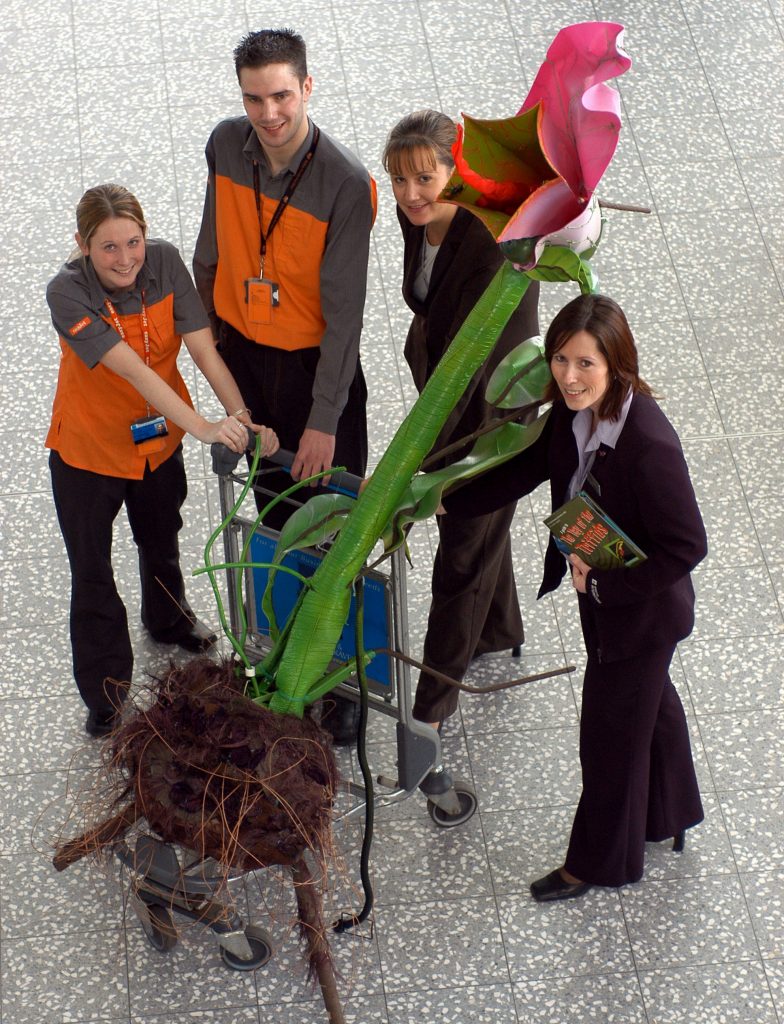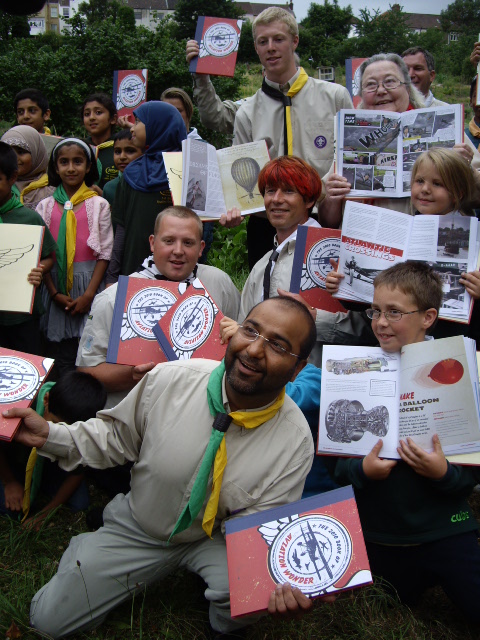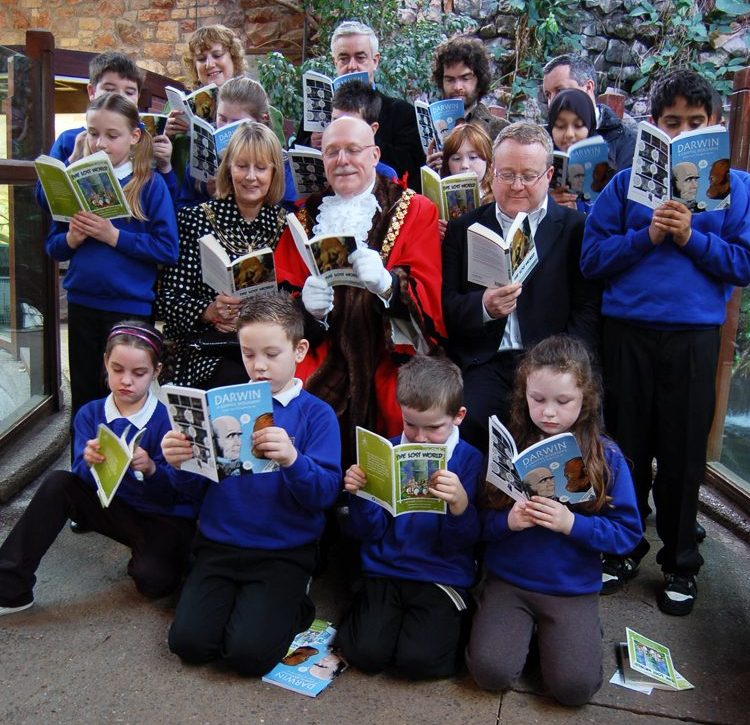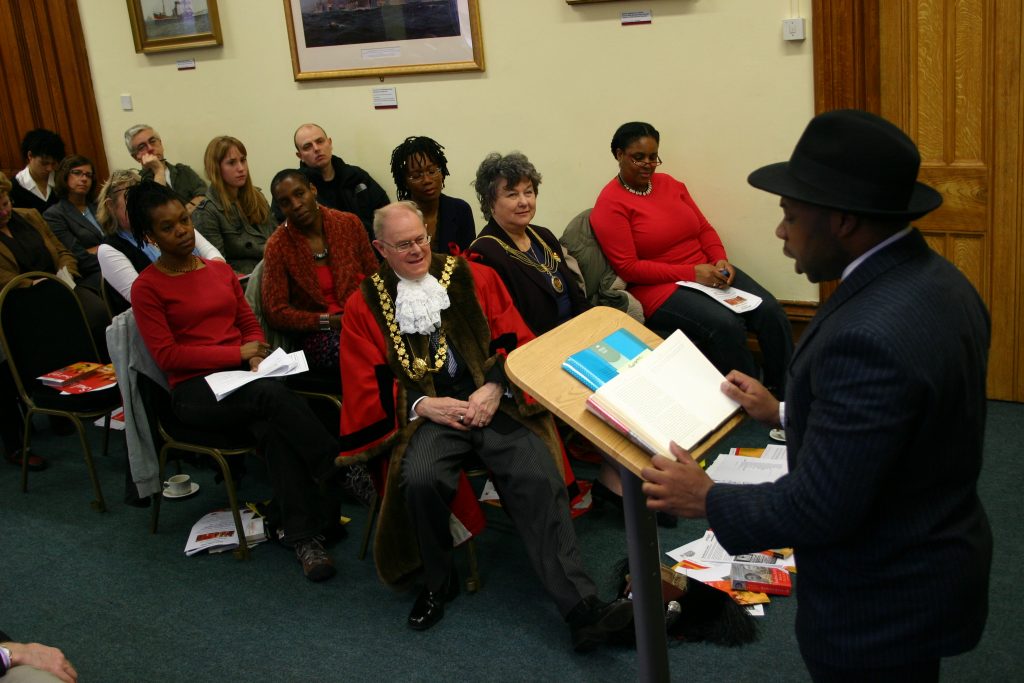The Great Reading Adventure
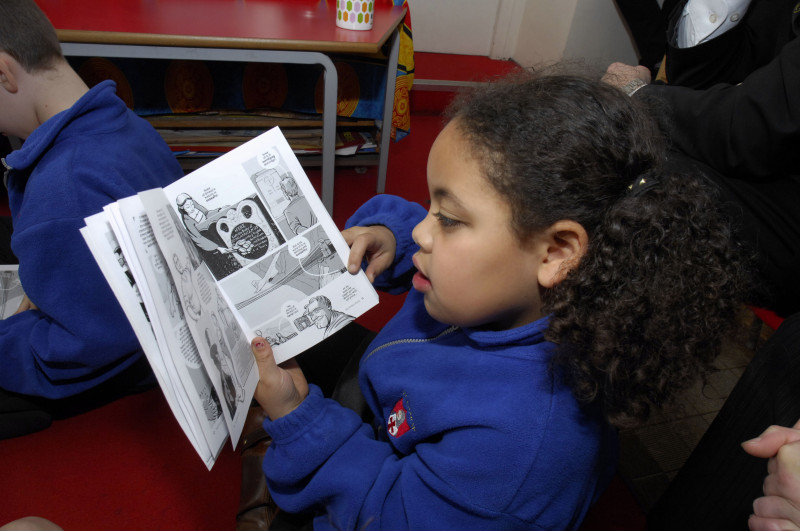
Share this
The Great Reading Adventure was an annual project that encouraged people to read more widely across the city.
It was launched on 6 March 2003, World Book Day. It was a community-focussed cultural initiative aimed to bring people together and raise standards of literacy by encouraging everyone in the city to read the same book at the same time. It was part of the build-up for the bid to be European Capital of Culture in 2008 and was organised by the Bristol2008 team and their partners, led by Bristol Cultural Development Partnership (BCDP – now known as Bristol Ideas).
Andrew Kelly had witnessed the impact of mass-reading projects when visiting Chicago in 2001. The city was then gripped by Harper Lee’s To Kill a Mockingbird, the book chosen for the first One Book, One Chicago project. He was taken by the idea of a single book capturing the imagination of an entire city and the opportunity for total strangers to discuss the book while travelling to work on the bus; for schools to be involved in linked literacy and arts projects; and for local businesses to set up reading groups. The Bristol Great Reading Adventure was the first time a reading project on this scale was held in the UK. It became an annual event until 2010 and was the cultural highlight of the year for many people.
Although the aims shifted slightly with each new project, the basic principles remained the same:
- To promote Bristol as a centre for reading.
- To encourage learning about the city’s past.
- To promote debate about the future of Bristol.
- To help develop standards of literacy.
- To get more people reading and writing.
Evaluation has shown that all ages and all socio-economic groups embraced the project across the Bristol city-region, helped in a large part by the involvement of the city’s branch libraries, schools and other centres of learning as well as the local print-media.
Treasure Island: 2003
GRA 2003 Readers Guide (PDF)
GRA 2003 Evaluation Report (PDF)
The book chosen for the first Great Reading Adventure was a thrilling tale of piracy and adventure by Robert Louis Stevenson that could be enjoyed by both children and adults and which has key scenes set in Bristol. On launch day actors from the street-art company Desperate Men, disguised as marauding pirates, sailed to the heart of Bristol’s Harbourside in the replica of John Cabot’s Matthew. Here they were greeted by hundreds of local school children, who received copies of the book and were entertained with juggling, sea shanties and cannon fire.
The central activity of the Great Reading Adventure was the distribution of 8,000 free copies of the Penguin Classic edition of the book. These were delivered in bulk to libraries (mainly for use as loan items, including sets given to reading groups), schools, the business community and Bristol City Council employees and members, or sent by post to individuals on request (a practice that eventually proved too costly to continue: the use of a variety of sites in the city where people could pick up copies became the preferred method for future projects). The books were donated by Penguin to mark the relaunch of its Classic series.
In addition, 340 Puffin and 145 Ladybird editions of Treasure Island and 56 Captain Pugwash books (for very young readers) were distributed. Bristol libraries purchased 35 large-print, ten video, three DVD and five European language versions for borrowers (alternative formats and languages were made available for all projects whenever possible). In addition to the free and loan copies circulating around the city, Treasure Island was in the top ten bestsellers list at Blackwell Bookshop on Park Street throughout the month the project ran – topping the list in the final week, beating books by Jamie Oliver and Michael Moore.
A high-quality illustrated readers’ guide was produced and also distributed free of charge. A programme of film screenings, lectures, competitions and puppet shows was mounted and people were encouraged to organise their own piratical happenings and reading group gatherings. The Bristol Evening Post serialised the book in 51 daily instalments, each illustrated in colour with pictures submitted by local school children (estimated to have had a readership of 168,000 people a day). A teachers’ pack, partly based on material produced for the Tobacco Factory adaptation of the book in 2002, was distributed to all schools in the city and there was a dedicated website which included an online Treasure Island web game and had over 3,000 visits.
Among the local companies that gave their support were Aardman Animations, who contributed artwork of Wallace and Gromit in pirate garb for use on support and promotional material; Bristol Evening Post and Press Ltd, who provided extensive coverage of the events; and the Society of Merchant Venturers. The first Great Reading Adventure formed part of the Bristol2008 promotional campaign, with special postcards and posters produced depicting local people reading the book with the tagline ‘Let’s Read it Together’.
The Day of the Triffids: 2004
GRA 2004 Readers Guide
GRA 2004 Evaluation Report
On 8 January 2004 something sinister was stirring at the Wildwalk botanical house in the heart of Bristol. Following reported sightings of a seven-foot tall homicidal plant, scientist and broadcaster Adam Hart-Davis, award-winning author Helen Dunmore, Bristol’s Lord Mayor and pupils from Severn Vale School wound their way through the steamy interior to investigate. There, beneath the tropical canopy, they encountered a towering triffid puppet and stacks of John Wyndham’s science fiction classic The Day of the Triffids. And so began Bristol’s second Great Reading Adventure, led once again by BCDP working in close collaboration with Bristol libraries and other partners. The project formed part of the Creative Bristol initiative, which aimed to deliver as much of the programme contained in Bristol’s bid to be Capital of Culture as possible.
Wyndham’s book was chosen because, as well as being an enthralling story, it could be used to promote Bristol as a place for science, innovation, creativity and green initiatives. The project ended officially on World Book Day, 4 March, although the reading of the book and some classroom and library activity continued after this date.
Among the materials distributed free of charge were: 4,100 copies of the Penguin Classic edition of The Day of the Triffids; 1,000 simplified versions of the book (Evans Fast Track Classics series); and 500 picture books on an environmental theme, Michael Foreman’s Dinosaurs and All That Rubbish. Rather than sending a small number of books to every centre of learning in the city, schools and colleges were asked to pre-register for classroom reading sets and educational packs. A total of 73 of these were then distributed.
As part of its 150th birthday celebrations J W Arrowsmith Ltd printed 10,000 readers’ guides for the project free of charge, along with feedback questionnaires and some of the publicity posters, which featured a special Aardman Animations Wallace and Gromit image. Arts & Business provided matched funding for Arrowsmith’s support through its New Partners Scheme. The guides and promotional material were designed by Qube Design Associates Ltd, who went on to design all the subsequent Great Reading Adventures. Qube also designed the project website, which had over 10,000 visits in the first three months. Grayling PR managed the media campaign free of charge.
A specially commissioned 12-part comic serial based on the book was published in the Bristol Evening Post, with an estimated readership of around 216,000 people a day. It was devised by local artist Simon Gurr. Artist-led workshops inspired by themes raised by the project took place in schools and libraries. There was also a science fiction weekend with screenings of classic films and television programmes, and lectures and discussions on Wyndham’s work. City Inn provided free accommodation for the speakers, who included the authors Brian Aldiss and Christopher Priest.
The Siege: 2005
GRA 2005 Readers Guide
GRA 2005 Evaluation Report
The Siege, by Bristol-based author Helen Dunmore, tells the poignant story of the suffering and survival of civilians in wartime, focussing on the first terrible winter of the 300-day siege of Leningrad in World War Two. BCDP distributed 4,500 free copies of the novel (published by Penguin) to schools, colleges, libraries, the business community and members of the public. For younger readers, 1,000 copies of Nina Bawden’s Carrie’s War and 1,000 copies of Dunmore’s Tara’s Tree House were used. 5,000 copies of the readers’ guide, 65 educational packs and a dedicated website were also made available to provide background material on Dunmore, the events at Leningrad and Bristol’s own wartime experience. The website had over 18,000 visits in its first three months. There was a significant increase in the number of artist-led workshops BCDP provided to schools and libraries including, for the first time, dance. (The archived website is still available but does not conform to current data protection requirements and we no longer have the access needed to edit it.)
2005 marked the 60th anniversary of the end of the war so it was apt that the Great Reading Adventure chose a book that allowed readers to reflect on the devastation and camaraderie of that period. BCDP was keen to encourage the sharing of wartime reminiscences and family stories before they were lost forever. The Bristol Evening Post published a daily archive photograph with accompanying explanatory text on the letters’ page of the newspaper throughout the project. On the weekend of 5-6 February a selection of feature films showing civilians under attack in wartime were shown at Watershed, interspersed with talks on different aspects of the experience of being under siege. In addition, Helen Dunmore was interviewed on stage by Sara Davies of the BBC. On 26 February there was An Afternoon with Helen Dunmore, an event for Bristol reading groups organised by the library service and held at the Fortune Theatre.
The 2005 Great Reading Adventure officially ended on 3 March 2005, World Book Day. Only seven per cent of those who returned a questionnaire had read the chosen book before compared with 37 per cent in 2004 and around 50 per cent in 2003. This was the first time support for the Great Reading Adventure was received from the Heritage Lottery Fund in recognition of the innovative way in which it engaged people in learning about their city’s past.
Around the World in Eighty Days: 2006
GRA 2006 Readers Guide
GRA 2006 Evaluation Report
This project formed part of the Brunel200 celebrations, which covered the whole of South West England and were led by BCDP. The chosen book was Jules Verne’s Around the World in Eighty Days, a story that captures the spirit of the Victorian age of fresh horizons and new ideas. It conveys the sense of daring and adventure brought by innovations that transformed the speed and reliability of travel across the globe. On 5 January 2006 a Victorian English gentleman, his French valet, an Indian princess and an incompetent detective could be seen travelling by train between Swindon and Penzance and by rickshaw around Weston-Super-Mare, heralding the first of 80 days of reading activity.
At the time this was the biggest and longest-running Great Reading Adventure to have taken place: 52,000 copies of the full-text edition of the book (provided at cost price by Oxford University Press with a special Aardman Animations-designed cover), 40,000 of the readers’ guide, 50,000 of a newly commissioned illustrated children’s adaptation and 200 copies of the picture book All Aboard were distributed free of charge across the region. In addition the children’s edition of Around the World in Eighty Days was serialised in six episodes in the Bristol Evening Post, Swindon Advertiser, Bath Chronicle, Torquay Herald Express and bbc.online.
The dedicated project website included extensive background information along with details of the wide range of activities taking place in the region’s schools, libraries and other venues including artist-led workshops, talks and puppet shows. (The archived website is still available but does not conform to current data protection requirements and we no longer have the access needed to edit it.) It had over 15,000 visits during its first three months. Readers were encouraged to share their own travel tales on the Phileas Blogg page. 1,000 copies of the full-text edition of Around the World in Eighty Days were used in a book crossing initiative. They were initially released at airports, train stations, bus depots and take-away food outlets. Each copy had a numbered sticker inside asking anyone who picked it up to let BCDP know where they found it. Books were tracked from Chinese restaurants in Plymouth; platform 19 at Edinburgh rail station; Gardermoen Airport in Oslo; a shopping mall in the suburbs of Prague; Ituzaingó in the Province of Buenos Aires; and the Sinai Desert, among other sites.
Small Island: 2007
GRA 2007 Readers Guide
GRA 2007 Evaluation Report
The Great Reading Adventure expanded further in its fifth year with a project that brought together Bristol and South West England, Liverpool and the North West, Hull and Glasgow. Overall coordination was by BCDP working in partnership with Liverpool Reads, Hull Libraries and Glasgow’s Aye Write! Book Festival. It ran from 11 January to 31 March 2007.
The chosen book was Andrea Levy’s Small Island, a widely acclaimed and award-winning novel that describes the arrival in post-war Britain of black Jamaican immigrants, the descendants of enslaved Africans. The project was linked to the 2007 commemorations of the 200th anniversary of the passing of the Slave Trade Abolition Bill. Levy’s novel addresses the themes of identity, racial awareness, forgiveness, ignorance and survival with humour, high drama, anger and pathos, making it an unforgettable read and a fitting topic for discussion in 2007. All the main cities that worked on the project had historic links to the slave trade as well as to its abolition.
50,000 free copies of a special edition of Small Island (published by Headline) that included references to the project were delivered across the country – from Glasgow to the tip of Cornwall – for distribution through libraries, schools, businesses, community centres and other sites. 80,000 copies of the readers’ guide giving background information about Levy, slavery and migration were distributed alongside the books. 8,000 copies of a special edition of Benjamin Zephaniah’s Refugee Boy and 3,000 copies of Mary Hoffman’s Amazing Grace were provided for the use of younger participants in the project. Over 100 public events took place including library talks, panel discussions, exhibitions and competitions plus over 60 artist-led school workshops. The website had over 20,000 visits in its first three months. (The archived website is still available but does not conform to current data protection requirements and we no longer have the access needed to edit it.)
The Bristol Story: 2008
GRA 2008 Readers Guide
GRA 2008 Evaluation Report
GRA 2008 The Bristol Comic
For this year the Great Reading Adventure went back to being an initiative for Bristol only. The project ran from 24 January to 31 March 2008. The chosen book was a specially commissioned graphic-style history of the city by writer Eugene Byrne and artist Simon Gurr aimed at a reading age of 11 and upwards. The Bristol Story was an entertaining, informative and sometimes challenging read of battles, killer diseases, daring (or mad) explorers, pirates, riots, sewage and what were described as brain- improving educational bits. 85,000 copies were distributed free of charge to libraries, schools, local businesses, community groups, scout and guide troops, bookshops, hospitals, heritage sites and individual members of the public. 10,000 copies of a special shortened adaptation – The Bristol Comic – were made available for younger or less confident readers.
Participants were encouraged to find out more about the city by also reading the accompanying support material (25,000 readers’ guides were distributed) and visiting the project website, which had 16,000 visits in three months. (The archived website is still available but does not conform to current data protection requirements and we no longer have the access needed to edit it.) This was the first time the Great Reading Adventure had been based upon a book that had not been previously published; one that was in a graphic format; and one that was non-fiction.
The Bristol Story was used as the city’s contribution to Portrait of a Nation, which was run by the Liverpool Culture Company, members of the Cultural Cities Network and the Heritage Lottery Fund. The campaign worked with young people across the UK to showcase their own local, regional and national identities through a series of events, which fed into a high-profile production that closed the Liverpool European Capital of Culture 2008 celebrations. In Bristol a programme of artist-led workshops was provided to 15 selected Bristol schools and college sites coinciding with the Great Reading Adventure. The participants created collages, comic books, written work and drama pieces on the themes of identity, roots, heritage and culture, focussing in particular on the city neighbourhoods in which they were based. A group of pupils from Hillfields Primary School, accompanied by teachers and BCDP staff, travelled to Liverpool to represent the city in a three-day event.
The Lost World Read: 2009
GRA 2009 Readers Guide
GRA 2009 Evaluation Report
The year 2009 marked the 200th anniversary of the birth of Charles Darwin and the 150th anniversary of the publication of his landmark book On the Origin of Species. The dual anniversary was celebrated throughout the world. One project which united large sections of the UK was The Lost World Read, a mass-reading of Sir Arthur Conan Doyle’s novel The Lost World to mark what would have been the Edinburgh-born author’s 150th birthday in addition to the Darwin anniversaries. It took place from January to March across the South West of England, Hampshire, Shropshire, the City of Westminster, Edinburgh and Glasgow. Overall coordination was by BCDP working with a wide range of partners.
During the course of the project, 45,000 free copies of the full-text version of The Lost World were distributed (a special edition published by Oxford University Press) along with 64,000 copies of a simplified version of the novel, which had an Aardman Animations-designed cover; 41,000 copies of a graphic biography of Charles Darwin by Eugene Byrne and Simon Gurr; and 30,000 copies of the readers’ guide. There were over 16,000 visits to the dedicated website during the project and over 700 people downloaded the unabridged audio version of the book. Over 130 events were listed on the website’s What’s On pages including more than 60 activities for children that took place during February half-term. (The archived website is still available but does not conform to current data protection requirements and we no longer have the access needed to edit it.)
2009 was the last full-scale, stand-alone Great Reading Adventure to be led by BCDP. In 2010 the project was part of the education programme within the BAC100 celebrations and 20,000 copies of The 2010 Book of Aviation Wonder were given away. In 2014 it formed part of Bristol2014 when 20,000 free copies of the book Bristol and the First World War were distributed. Both projects had a section within the main programme websites rather than a website of their own. Since then BCDP has distributed free books as part of the Festival of Ideas: 1,000 copies of The Autobiography of Malcolm X in 2015 to mark the 50th anniversary of its publication and Malcolm X’s death and 50 copies of Mary Shelley’s Frankenstein in 2016. Both of these projects included providing books to staff and inmates at HMP Bristol.
Having begun with the commitment that the books should be provided to all free-of-charge, the full-scale Great Reading Adventure became a prohibitively expensive enterprise in a time of dwindling funding. It would have been against the spirit of the project to have expected individual readers to pay to take part. It was also felt that the Great Reading Adventure served to celebrate the joy of physically holding a book and, although some material could be downloaded in digital format, it was the books themselves that were to be treasured. It was particularly important that as many people as possible had the opportunity to own a book to keep for future generations or to share with friends, family and neighbours.
Among the feedback comments received from readers over the years are:
- Treasure Island: ‘This is a story that has stuck in my memory for over 60 years and reading it again now that I am living near Bristol rekindles the excitement of a stirring adventure story.’
- Treasure Island: ‘It’s one of the ones I always meant to read and now I have I’m very pleased. It’s a riveting read. As an adult reader of a book written for children, it held my interest completely… ‘
- The Day of the Triffids: ‘To my surprise I really enjoyed it and found it a real page-turner. The story was so well written and, in view of recent scientific developments, only too credible. Some serious points were made in a way that was never heavy.’
- The Day of the Triffids: ‘Excellent. Compulsive and thought-provoking. You know it’s a good book if you find yourself thinking about it the next morning at work.’
- The Siege: ‘This was a great way to make me read a book I wouldn’t otherwise have heard of or chosen to read. I found it was an intricate exploration of the hardships of war. Also a great way to boost the profile of a local author.’
- The Siege: ‘I have passed the book on to my daughter. I hope she will appreciate what it is like to live under such terrible conditions.’
- Around the World in Eighty Days: ‘Once I’d got used to the style, I found it impossible to stop reading. The Great Reading Adventure is a fantastic idea as I would never normally have read this book. It’s also nice to know a lot of other people are reading it too. Thank you!’
- Small Island: ‘I’d thought about reading it for ages, and this spurred me on. I couldn’t put it down! The Small Island Read project was a great way to introduce me to an amazing book.’
- Small Island: ‘Thought I would struggle with it as it’s not my type of read, but I enjoyed it – humorous but thought-provoking.’
- The Bristol Story: ‘Loved it. Read it in one sitting and, despite a prior interest in local history, found much in it that I didn’t already know. I especially liked the tone – a very engaging mix of fun and fact.’
- The Bristol Story: ‘I have lived in Bristol all my life and The Bristol Story told me so many new things! There should be one for every city in the world!’
- The Lost World: ‘I really enjoyed the book. It made me feel like a small boy again as it stirred up and fed my imagination that has been neglected for a long time, it seems.’
- The Lost World: ‘I am 58 years old, female and I don’t think there is a “wrong age” to read this book. I know I would have read it with the same excitement in my teenage years… I think anyone interested in evolution, science, our planet will find the book a very pleasant read. Thank you for making this available to us.’
The Bristol Great Reading Adventure showed the magic of books and reading and of sharing that experience widely. It highlighted the importance of libraries to many parts of the city. And it was fun to do. Like many BCDP projects, a one-year test was run to see if this would work.
The success of Treasure Island meant that many more annual projects were possible, some of which would go national and be UK-wide. In many ways it was the BCDP project that reached the largest and widest range of people.
